首先给大家看一下 NewRelic 的报表
最近 24h 的平均响应时间
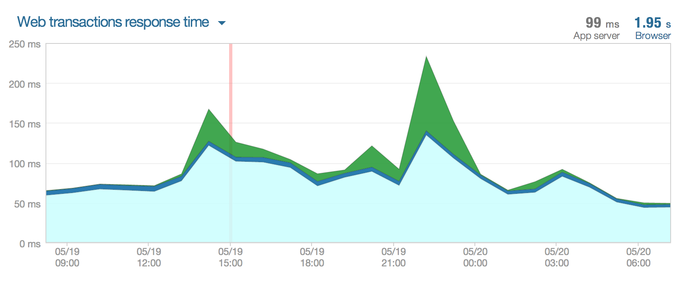
流量高的那些页面 (Action)
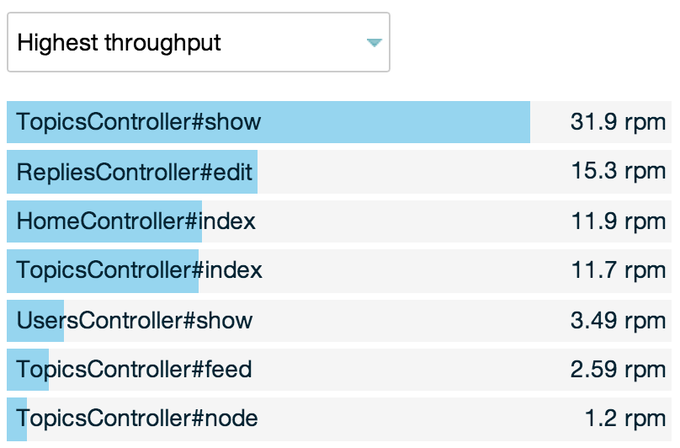
访问量搞的几个 Action 的情况:
TopicsController#show
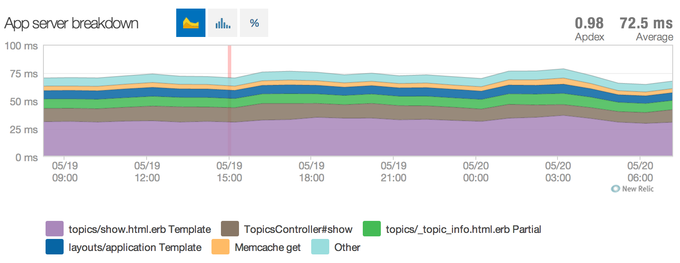
UsersController#show (比较惨,主要是 GitHub API 请求拖慢)
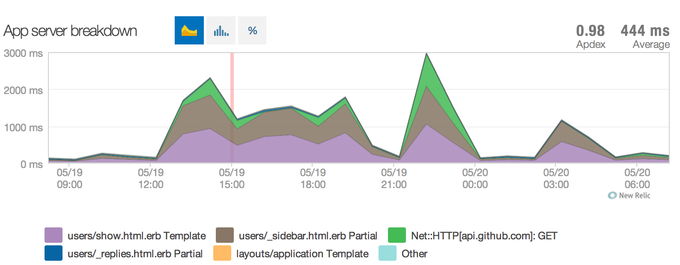
PS: 在发布这篇文章之前我有稍加修改了一下,GitHub 请求放到后台队列处理,新的结果是这样:
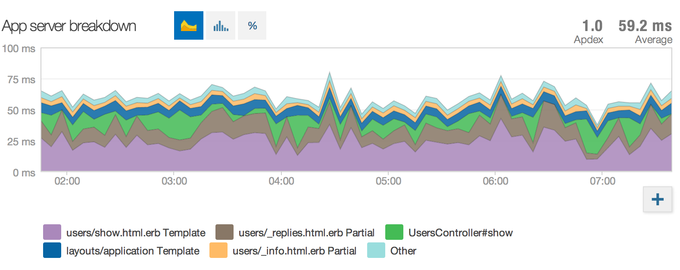
TopicsController#index
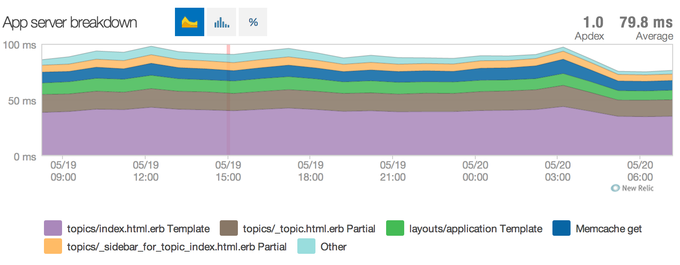
HomeController#index

从上面的报表来看,目前 Ruby China 后端的请求,排除用户主页之外,响应时间都在 100ms 以内,甚至更低。
我们是如何做到的?
Markdown 缓存
Fragment Cache
数据缓存
ETag
静态资源缓存 (JS,CSS,图片)
Markdown 缓存
在内容修改的时候就算好 Markdown 的结果,存到数据库,避免浏览的时候反复计算。
此外这个东西也特意不放到 Cache,而是放到数据库里面:
为了持久化,避免 Memcached 停掉的时候,大量丢失;
避免过多占用缓存内存;
class Topic
field :body # 存放原始内容,用于修改
field :body_html # 存放计算好的结果,用于显示
before_save :markdown_body
def markdown_body
self.body_html = MarkdownTopicConverter.format(self.body) if self.body_changed?
end
end
Fragment Cache
这个是 Ruby China 里面用得最多的缓存方案,也是速度提升的原因所在。
app/views/topics/_topic.html.erb
% cache([topic, suggest]) do %>
div class="topic topic_line topic_%= topic.id %>">
%= link_to(topic.replies_count,"#{topic_path(topic)}#reply#{topic.replies_count}",
:class => "count state_false") %>
... 省略内容部分
/div>
% end %>
用 topic 的 cache_key 作为缓存 cache views/topics/{编号}-#{更新时间}/{suggest 参数}/{文件内容 MD5} -> views/topics/19105-20140508153844/false/bc178d556ecaee49971b0e80b3566f12
某些涉及到根据用户帐号,有不同状态显示的地方,直接把完整 HTML 准备好,通过 JS 控制状态,比如目前的“喜欢“功能。
script type="text/javascript">
var readed_topic_ids = %= current_user.filter_readed_topics(@topics) %>;
for (var i = 0; i readed_topic_ids.length; i++) {
topic_id = readed_topic_ids[i];
$(".topic_"+ topic_id + " .right_info .count").addClass("state_true");
}
/script>
再比如
app/views/topics/_reply.html.erb
% cache([reply,"raw:#{@show_raw}"]) do %>
div class="reply">
div class="pull-left face">%= user_avatar_tag(reply.user, :normal) %>/div>
div class="infos">
div class="info">
span class="name">
%= user_name_tag(reply.user) %>
/span>
span class="opts">
%= likeable_tag(reply, :cache => true) %>
%= link_to("", edit_topic_reply_path(@topic,reply), :class => "edit icon small_edit", 'data-uid' => reply.user_id, :title => "修改回帖")%>
%= link_to("", "#", 'data-floor' => floor, 'data-login' => reply.user_login,
:title => t("topics.reply_this_floor"), :class => "icon small_reply" )
%>
/span>
/div>
div class="body">
%= sanitize_reply reply.body_html %>
/div>
/div>
/div>
% end %>
同样也是通过 reply 的 cache_key 来缓存 views/replies/202695-20140508081517/raw:false/d91dddbcb269f3e0172bf5d0d27e9088
同时这里还有复杂的用户权限控制,用 JS 实现;
script type="text/javascript">
$(document).ready(function(){
% if admin? %>
$("#replies .reply a.edit").css('display','inline-block');
% elsif current_user %>
$("#replies .reply a.edit[data-uid='%= current_user.id %>']").css('display','inline-block');
% end %>
% if current_user !@user_liked_reply_ids.blank? %>
Topics.checkRepliesLikeStatus([%= @user_liked_reply_ids.join(",") %>]);
% end %>
})
/script>
数据缓存
其实 Ruby China 的大多数 Model 查询都没有上 Cache 的,因为据实际状况来看, MongoDB 的查询响应时间都是很快的,大部分场景都是在 5ms 以内,甚至更低。
我们会做一些比价负责的数据查询缓存,比如:GitHub Repos 获取
def github_repos(user_id)
cache_key = "user:#{user_id}:github_repos"
items = Rails.cache.read(cache_key)
if items.blank?
items = real_fetch_from_github()
Rails.cache.write(cache_key, items, expires_in: 15.days)
end
return items
end
ETag
ETag 是在 HTTP Request, Response 可以带上的一个参数,用于检测内容是否有更新过,以减少网络开销。
过程大概是这样
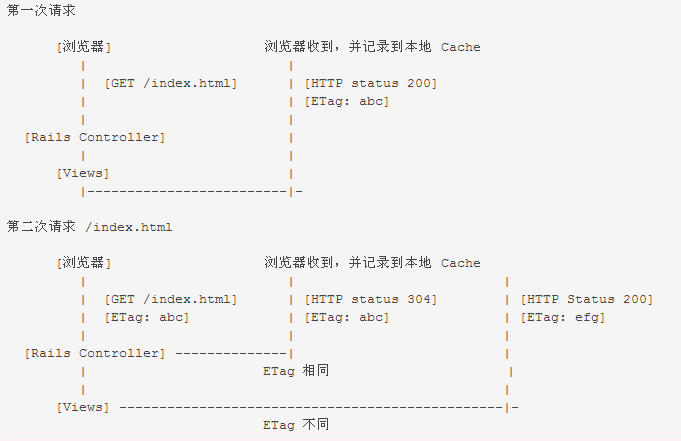
Rails 的 fresh_when 方法可以帮助将你的查询内容生成 ETag 信息
def show
@topic = Topic.find(params[:id])
fresh_when(etag: [@topic])
end
静态资源缓存
请不要小看这个东西,后端写得再快,也有可能被这些拖慢(浏览器上面的表现)!
1、合理利用 Rails Assets Pipeline,一定要开启!
# config/environments/production.rb
config.assets.digest = true
2、在 Nginx 里面将 CSS, JS, Image 的缓存有效期设成 max;
location ~ (/assets|/favicon.ico|/*.txt) {
access_log off;
expires max;
gzip_static on;
}
3、尽可能的减少一个页面 JS, CSS, Image 的数量,简单的方法是合并它们,减少 HTTP 请求开销;
head>
...
只有两个
link href="//ruby-china-files.b0.upaiyun.com/assets/front-1a909fc4f255c12c1b613b3fe373e527.css" rel="stylesheet" />
script src="//ruby-china-files.b0.upaiyun.com/assets/app-24d4280cc6fda926e73419c126c71206.js">/script>
...
/head>
一些 Tips
看统计日志,优先处理流量高的页面;
updated_at 是一个非常有利于帮助你清理缓存的东西,善用它!修改数据的时候别忽略它!
多关注你的 Rails Log 里面的查询时间,100ms 一下的页面响应时间是一个比较好的状态,超过 200ms 用户就会感觉到迟钝了。
您可能感兴趣的文章:- Ruby On Rails中如何避免N+1问题
- ruby开发vim插件小结
- 优化Ruby脚本效率实例分享
- Java版的Ruby解释器 JRuby简介
- ruby执行周期性任务的三种gem介绍
 咨 询 客 服
咨 询 客 服